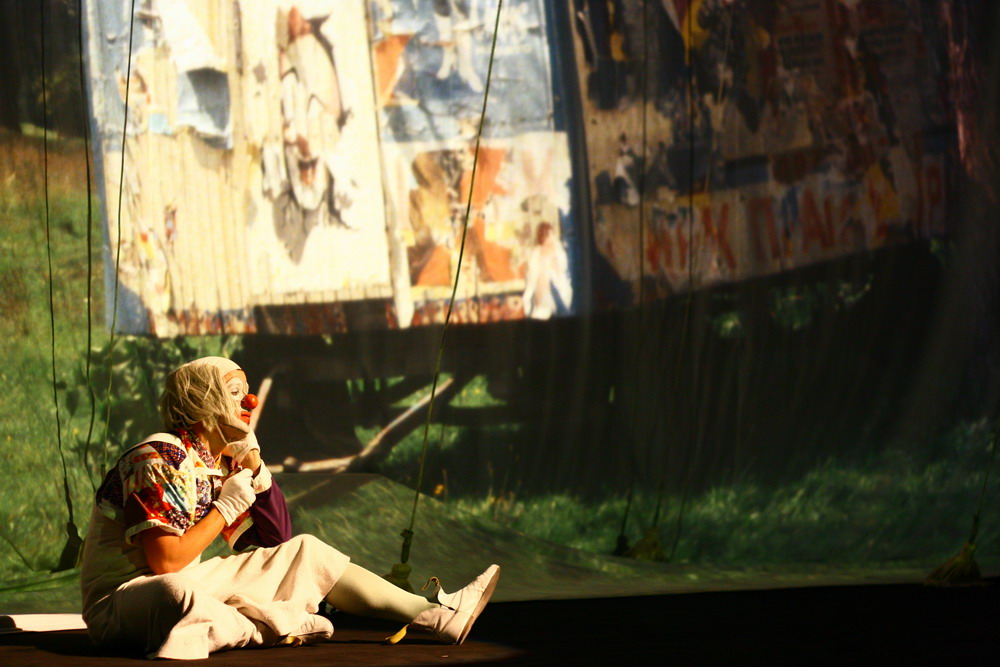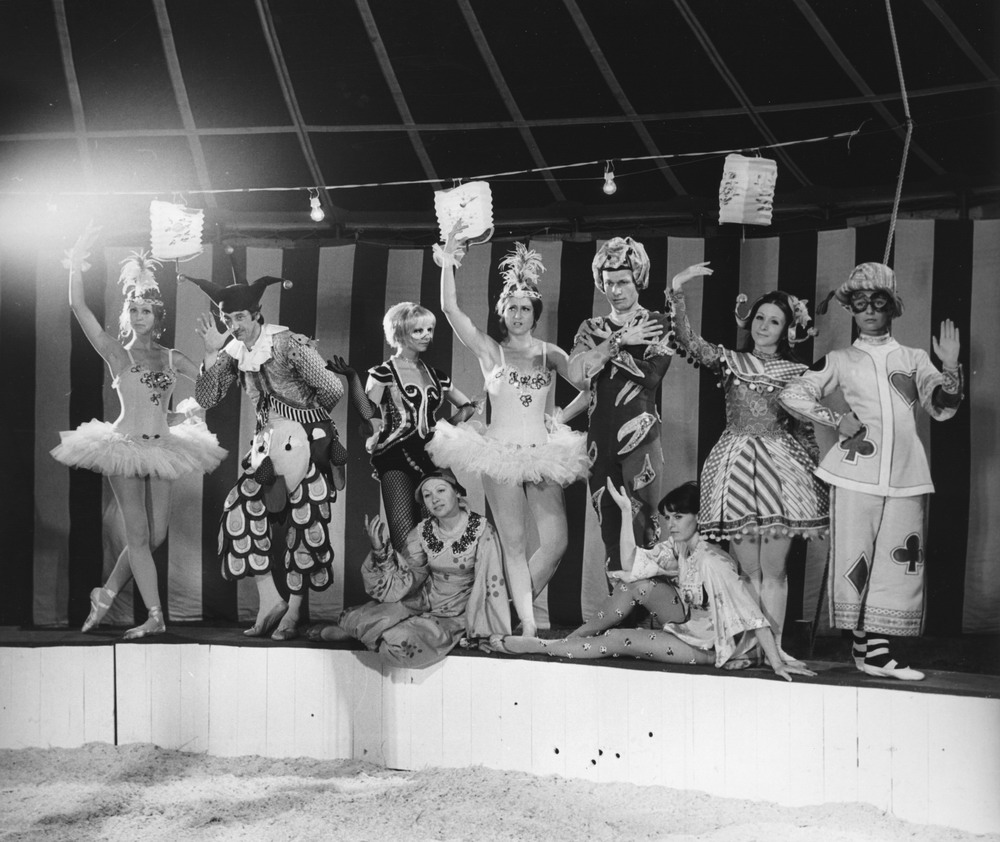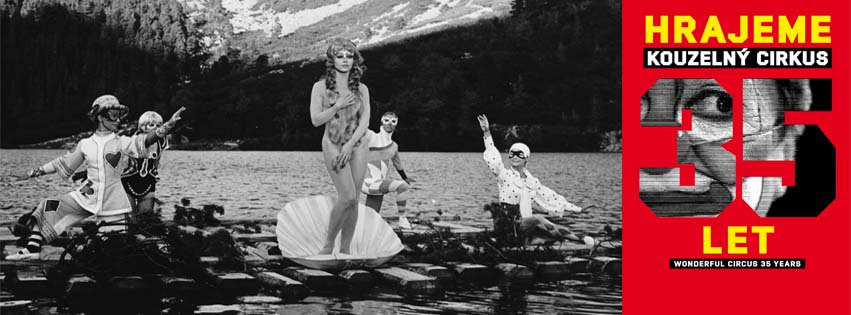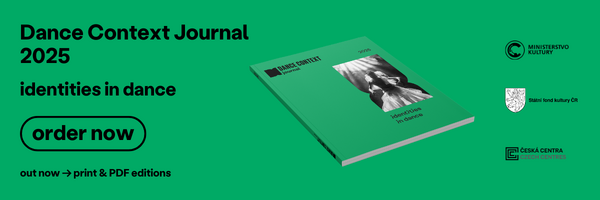Laterna Magika´s Wonderful Circus: 35 Years on Stage
 An important anniversary is coming up for Laterna Magika after Easter. On April 14th one of its shows, The Wonderful Circus will be performed for the 6,167th time and will celebrate exactly 35 years since its premiere in 1977. Telling a story of the pilgrimage of two clowns, The Wonderful Circus is a legendary show created by such big names as Evald Schorm, Jiří Srnec and Jan Švankmajer. It has toured and gained critical acclaim around the world: today it is still on at the New Stage of the National Theatre. The off programme of its anniversary offers a number of events, among them an exhibition of theatre posters or a photography happening with the performers of the original version of the show at the piazzeta of the National Theatre.
The Wonderful Circus was first shown at Adria Palace, then a permanent space of Laterna Magika. During summer holidays it used to be performed at the congress hall of what was then called the Palace of Culture. Later, the piece has moved to the New Stage where it has been performed ever since the opening of the building in 1983.
An important anniversary is coming up for Laterna Magika after Easter. On April 14th one of its shows, The Wonderful Circus will be performed for the 6,167th time and will celebrate exactly 35 years since its premiere in 1977. Telling a story of the pilgrimage of two clowns, The Wonderful Circus is a legendary show created by such big names as Evald Schorm, Jiří Srnec and Jan Švankmajer. It has toured and gained critical acclaim around the world: today it is still on at the New Stage of the National Theatre. The off programme of its anniversary offers a number of events, among them an exhibition of theatre posters or a photography happening with the performers of the original version of the show at the piazzeta of the National Theatre.
The Wonderful Circus was first shown at Adria Palace, then a permanent space of Laterna Magika. During summer holidays it used to be performed at the congress hall of what was then called the Palace of Culture. Later, the piece has moved to the New Stage where it has been performed ever since the opening of the building in 1983.
The Wonderful Circus was performed as many as 5,630 times in the Czech Republic and 540 times around as many as 50 cities in 16 other countries of the world (D, SK, NL, USA, B, SSSR, I, CAN, F, BG, A, Israel, E, S, TR, DK). The extraordinary success of the show is reflected in theatre reviews dating from the first decade of its existence: “... the fixed metaphor of clowns being born of an egg and striving to fulfil their destiny is here transformed into theatre magic stronger than ever before. (…) Applying the black-light theatre approach, the authors of the piece have created a bewildering theatre piece. I was simply bewitched.“ Clive Barnes, New York Post, 23.2. 1979
Another striking piece of statistical data is that if the show had been performed once every night it would have filled the theatre's calendar for as long as sixteen years. The show also brought up several generations of theatregoers and dancers: to date, the production has featured as many as 21 Sad Clowns, 23 Jolly Clowns, 21 Seducers and 29 Venuses. “The Wonderful Circus is an emblematic piece of Laterna magika and a unique piece in the whole history of Czech theatre. I am very pleased that, together with the Club of Donators of the National Theatre, we have managed to provide for new energy for the piece in the form of the digitalization of the film strip,” comments Ondřej Černý, the director of the National Theatre.
The poetic story on the eternal search for beauty revolves around the pilgrimage of two clowns in search of an unattainable Venus while they have to overcome plots of the Seducer who brought them to life and who longs to control them. It has enchanted thousands of spectators by the changing of sets that had been shot in the outside scenery around the whole Czechoslovakia. Other assets of the show are its humorous scenes and the choreography, designed by five choreographers, with Karel Vrtiška in the role of the leading choreographer. Still today the piece conveys a very strong signature of the extraordinary team that has created it: the direction was done by Evald Schorm, the scenic design by
Josef Svoboda, the puppets by
Jiří Srnec, the founder of the Backlight Theatre, the setting of the puppet scenes by
Jan Švankmajer. Oldřich F. Korte was in charge of the original music and music dramaturgy and
Zdeněk Seydl designed the stage and the costumes.
 In 2011 Jiří Srnec recalled the creation of the Wonderful Circus in the following words: “It was an extraordinary team that gathered in 1976. Evald Schorm in person was inciting artists to get involved. During the first meeting a few words were pronounced on the theme, the two clowns and their love for the Venus. Only the orthodox ones, the true believers gathered for the following meeting. From the very beginning the miracle of mutual understanding was growing. It was great to be a part of this. A new space had opened, a space for the so far unseen. Stage rehearsals followed very soon. The artistic virtuosity, ballet, clownery and the sophisticated dance of the rose.
In 2011 Jiří Srnec recalled the creation of the Wonderful Circus in the following words: “It was an extraordinary team that gathered in 1976. Evald Schorm in person was inciting artists to get involved. During the first meeting a few words were pronounced on the theme, the two clowns and their love for the Venus. Only the orthodox ones, the true believers gathered for the following meeting. From the very beginning the miracle of mutual understanding was growing. It was great to be a part of this. A new space had opened, a space for the so far unseen. Stage rehearsals followed very soon. The artistic virtuosity, ballet, clownery and the sophisticated dance of the rose.
A real circus tent was built up on one of the large meadows in the park Stromovka. We heard the sound of the trumpet, the sun was rising from the waves of the sea. All the searching, offering and finding... All of that witnessed by the smiling, kind and serene Evald Schorm, the director with a black halo of his hair.
I had a script ready for the hot air balloon scene. I went to talk to Evald because I needed a film for it. He said: -“Shoot it yourself.” -”I've never done it before.” He replied: “Everyone is a filmmaker until they have proved not to be one.” … and so it was, that's how the scene with the beautiful music by Oldřich Korte was done.”
The Wonderful Circus fuses film, theatre, music and dance. According to the official evaluation text on the piece written by the artistic director of Laterna magika at the time, Jiří Srnec, its primary goal in 1977 was to “examine whether Laterna Magika is an open system and in what ways it should be effectively developed towards poetic theatre.”
Given the conditions of the late 1970s, the creation of the piece was rather difficult especially in terms of production and coordination. For example, each role was rehearsed with two alternations. Also, for the sake of Josef Svoboda's scenic design a specific film needed to be recorded simultaneously on three cameras: in total, the film required 53,000 meters of film material. The neuralgic points of the creative process are documented in a report by Josef Svoboda: “The film could only be edited on a multiple editing machine: only the institution of Krátký Film had one at the time and they had very strict policy on not lending it to anyone. However, there was another machine of the kind in the Czech Republic: Artcentrum had borrowed one from abroad and they allowed us to use it rather illegally at nights and during weekends. This naturally meant that our work was proceeding very slowly. Hundreds of boxes with film material needed to be transferred back and forth so that no one found out that we were working at Artcentrum. (...) It should also be noted here that Laterna magika disposed of a microbus the driver of which only worked from 7.00 am to 3.45 pm and who was not willing to carry anything in his hands because, as he explained: “He was just a bus driver.”
The original film is now in the process of digitalization at the Barrandov Film Studios. This has been kindly enabled by financial support from the Club of Donators of the National Theatre. April 14th will thus be one of the last dates when the show will be performed with the original film strip.
 OFF PROGRAMME
At the occasion of the anniversary the New Stage and Laterna Magika have organized a unique exhibition of theatre posters and materials from the archives that reflect upon the 35 years of The Wonderful Circus and its traveling around the world. The exhibition will be opened on April 10th at the central staircase at the New Stage, and will last until April 30th.
Saturday, April 14th will see a photography happening at the National Theatre piazzeta: its goal is to take a picture of all living performers who have ben a part of the Wonderful Circus. The happening will take place from 6.30 pm to 7 pm at the piazzeta or, in case of inclement weather, at the upper foyer of the New Stage.
The April programme leaflet of the New Stage marks the anniversary with a title picture showing Josef Kotěšovský, the original performer from the 1977 premiere, in a role of a clown. Laterna Magika has also released a special anniversary graphic design an a limited edition of t-shirts.
The Wonderful Circus is on the programme on April 14th at 5pm and at 8 pm. The evening show has a surprise. Tickets for both shows are on sale.
OFF PROGRAMME
At the occasion of the anniversary the New Stage and Laterna Magika have organized a unique exhibition of theatre posters and materials from the archives that reflect upon the 35 years of The Wonderful Circus and its traveling around the world. The exhibition will be opened on April 10th at the central staircase at the New Stage, and will last until April 30th.
Saturday, April 14th will see a photography happening at the National Theatre piazzeta: its goal is to take a picture of all living performers who have ben a part of the Wonderful Circus. The happening will take place from 6.30 pm to 7 pm at the piazzeta or, in case of inclement weather, at the upper foyer of the New Stage.
The April programme leaflet of the New Stage marks the anniversary with a title picture showing Josef Kotěšovský, the original performer from the 1977 premiere, in a role of a clown. Laterna Magika has also released a special anniversary graphic design an a limited edition of t-shirts.
The Wonderful Circus is on the programme on April 14th at 5pm and at 8 pm. The evening show has a surprise. Tickets for both shows are on sale.
Source: Laterna Magika






